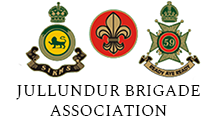WHO WERE THE JULLUNDUR BRIGADE?
In the 1900s the British Empire had expanded across the world and had influence in many countries, including India. For this reason, The Indian Army provided a great number of soldier to fight for the British in World War One. During this time a unique brigade was formed in Jullundur, it consisted of three different battalions from different countries, with different cultures and beliefs. Yet they would form friendships and comradery which would see them through what was to come.
The three battalions remained together as part of the Jullundur Brigade before, throughout and after the Great War (1912 - 1919), having fought with great distinction in northern France and Flanders, and later in Palestine and Mesopotamia. They have remained bonded together in friendship even though they are now part of three different Armies.
The Jullundur Brigade Association is constituted to maintain those close links by regular meetings of its membership, wherever and whenever that is possible.
THE BATTALIONS:
1st Manchester's
The 1st Manchester's were serving in India when the Great War broke out, they had travelled around the country as a part of their commitment to protecting the British Empire.
Whilst serving in India, they trained alongside Indian soldiers and also became more familiar with their culture and language so they could communicate more effectively.
47th Sikh Regiment
The 47th Sikh's were formed in the 1900, the government stated that it had to consist of Jatt Sikhs and Punjabi soldiers, as well as fit a specific physical criteria.
The Regiment impressed many commanding officers in the army with their skills and physique; including German Field Marshall Waldersee, who they would later fight against in the War.
The 59th Scinde
The soldier of the Scinde Rifles Regiment were made up of men from Sikh, Hindu and Muslim religions. The regiment had taken part in many campaigns across the British Empire from the 19th century onwards.
Their Lieutenant, William Bruce was awarded the Victoria Cross for bravery and dedication to his duty during the War.
Founder: Major General Mohindar Singh Chopra IOH
President: Major General Peter Davies CB
Secretary General: Mr Pushpindar Singh Chopra
Related Links:
- Visit the Museum of the Manchesters website >>
The Museum of the Manchesters tells the story of The Manchester Regiment in an imaginative and visually stimulating manner.
The Museum of the Manchesters
C/O Portland and Basin Museum
Portland Place
Heritage Wharf
Ashton-under-Lyne
OL7 0QA
Tel: 0161 343 2878
- Anglo Sikh Heritage Trail
Preserving the past, inspiring the future. A site dedicated to renewing the memory of Sikh heritage in Britain.
email: [email protected]
- Indian Military Historical Society
33 High Street
Tilbrook
Huntingdon
Cambridgeshire
PE28 0JP
United Kingdom
email: [email protected]
Download: membership flyer >>
- The Duke of Lancaster's Regiment >>
The successor Regiment to The Manchester Regiment and The King's Regiment
RHQ, The Duke of Lancaster's Regiment
Fulwood Barracks
Preston
Lancashire
PR2 8AA
Tel: +44 (0) 1772 260 362
Email: [email protected]
